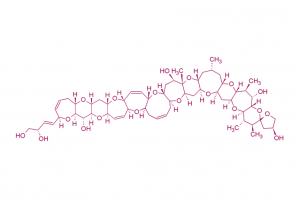PACKAGING AND PRICE
| Quantity |
Price(€) |
| 0.5 µg |
1 750.00 € |
| 1.0 µg |
3 500.00 € |
CTX1B is sent in powdered form
REFERENCES
[1] Legrand A.M., Litaudon M., Genthon J.N., Bagnis R., Yasumoto T. (1989). Isolation and some properties of ciguatoxin. Journal of applied phycology, 1(2) 183-188. https://doi.org/10.1007/BF00003882
[2] Mak Y. L., Wai T.-C.; Murphy M. B., Chan W. H., Wu J. J., Lam J. C. W., Chan L. L., Lam P. K. S. (2013). Pacific ciguatoxins in food web components of coral reef systems in the Republic of Kiribati. Environ. Sci. Technol. 2013,14070-14079. https://doi.org/10.1021/es403175d
[3]Food and Agriculture Organization of the United Nations & World Health Organization. (2020). Report of the expert meeting on ciguatera poisoning: Rome, 19-23 November 2018. World Health Organization. https://apps.who.int/iris/handle/10665/332640
[4] Lombet A., Bidard J.N., Lazdunski M. (1987). Ciguatoxin and brevetoxins share a common receptor site on the neuronal voltage‐dependent Na+ channel. FEBS letters, 219(2), 355-359. https://doi.org/10.1016/0014-5793(87)80252-1
Material Safety Data Sheet available on demand. Contact us.


